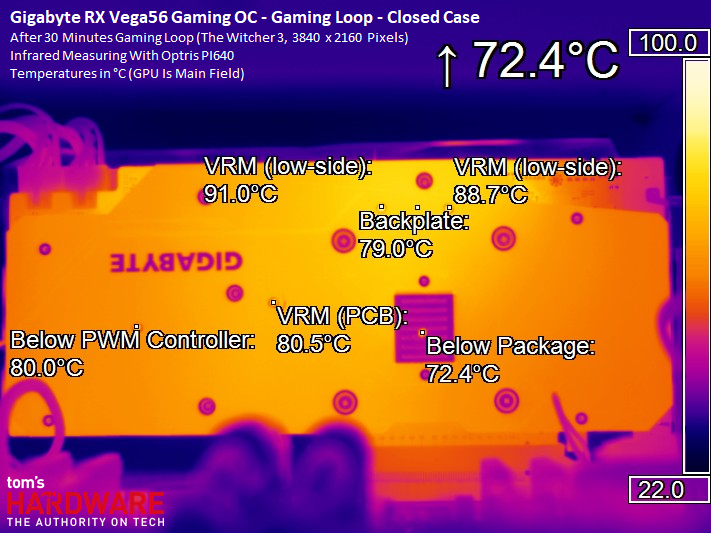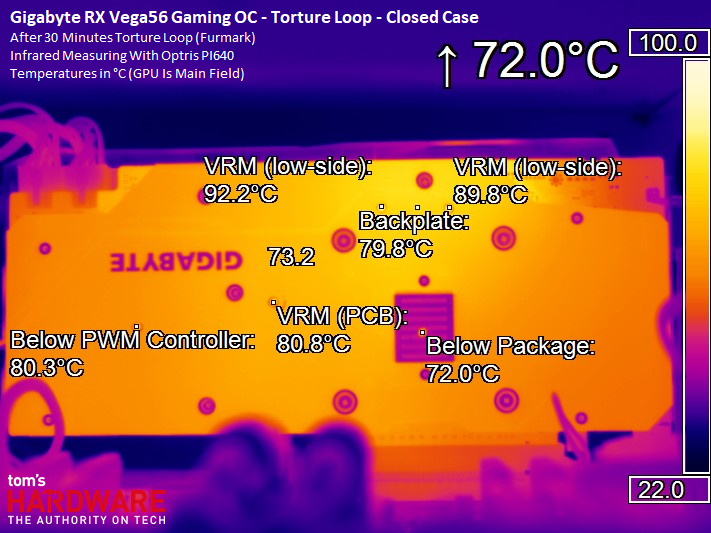Hot Vega: Gigabyte Radeon RX Vega 56 Gaming OC 8G Review
Why you can trust Tom's Hardware
Temperatures, Clock Rates & Overclocking
Overclocking & Undervolting
Conventional overclocking through a higher power limit and more aggressive clock rate is a dead-end. Brute force just isn't the answer. Because Gigabyte had to follow AMD's guidelines, this implementation is already running at its limit. Sure, you could dial in higher fan speeds to cool things down, creating more noise in the process, but who really wants that? As we explained in AMD RX Vega 64: The Tom's Hardware Liquid Cooled Edition, even with higher frequencies and brutal power adjustments, it is almost impossible to get Radeon RX Vega running much faster. Instead, undervolting can achieve far better results.
First and foremost, the use of a suitable utility like OverdriveNTool works wonders. As always, though, your results will also depend on the quality of your GPU. We can't generalize; you'll have to compare your improvements to ours.
Temperatures & Frequencies
We’re using the GPU temperature value exclusively because that's what our test sample’s telemetry reports. Of course, the hot-spot temperature is a lot higher. Why? You can read all about in Does Undervolting Improve Radeon RX Vega 64's Efficiency? On Gigabyte's Radeon RX Vega 56 Gaming OC 8G, those readings are up to 15°C higher. But they never hit a level that could cause problems.
The following table shows a comparison of start and end values for temperatures and GPU (boost) frequencies:
| Header Cell - Column 0 | Initial Value | Final Value |
|---|---|---|
| Open Test Bench | ||
| GPU Temperature | 44°C | 74-75°C |
| GPU Clock Rate | 1378 MHz | 1352 MHz |
| Ambient Temperature | 22°C | 22°C |
| Closed Case | ||
| GPU Temperature | 46°C | 74-75°C |
| GPU Clock Rate | 1378 MHz | 1344 MHz |
| Air Temperature in Case | 24°C | 47°C |
Temperature vs. Frequency
To better illustrate our findings, we plotted temperatures and frequencies during our sample's 15-minute warm-up phase:
Frequencies in the gaming loop are about 100 MHz higher than what we measured from AMD's reference card. This average increase of ~10% results in 40W-higher power consumption, or a roughly 18% increase. But the frame rates only go up by 5-7%, which is not a good trade-off at all.
The results of our stress test look similar:
Get Tom's Hardware's best news and in-depth reviews, straight to your inbox.
IR Image Analysis For The Board's Back
To round out this section, we take a look at board temperatures across several different load levels. To keep the test setup as real-world as possible, we drilled a couple of small holes through the backplate at the points relevant to our IR measurements, and then cut out the thermal pads where necessary. Since the diameter of these holes is very small, they have no significant impact on the cooler's performance.
Gaming
It's easy to see that the card is already at its limits during our gaming loop. As long as you operate the Radeon RX Vega 56 Gaming OC 8G vertically on an open test bench, all values seem to be acceptable. But this may change quickly if the card is installed in a closed case instead.
Once we popped Gigabyte's board into a closed case, we measured up to 6°C-higher temperatures at the voltage converters. It seems as though the fans only respond to GPU temperature, unfortunately. Even a slightly higher rotational speed would have dropped the temperatures by four or five degrees without becoming unpleasantly loud.
Stress Test
The stress test reflects slightly lower power consumption than our gaming benchmark, so the GPU stays a little cooler.
Even in a closed case, temperatures don't increase by more than a couple of degrees. Still, the 92°C we measured on some of the voltage converters seems quite a bit higher than necessary.
MORE: Best Graphics Cards
MORE: Desktop GPU Performance Hierarchy Table
MORE: All Graphics Content
Current page: Temperatures, Clock Rates & Overclocking
Prev Page Power Consumption Next Page Cooling & Noise
Igor Wallossek wrote a wide variety of hardware articles for Tom's Hardware, with a strong focus on technical analysis and in-depth reviews. His contributions have spanned a broad spectrum of PC components, including GPUs, CPUs, workstations, and PC builds. His insightful articles provide readers with detailed knowledge to make informed decisions in the ever-evolving tech landscape
-
marcelo_vidal With the pricey from those gpus :) I will get an 2400g and play 720P. maybe with a little tweaking I can boost to 1920x1080Reply -
Sakkura This thing about board partners only getting a few thousand Vega 10 GPUs goes back many months now. Has AMD just not been making any more? What the heck is going on?Reply
Seems like Gigabyte did a really nice job making an affordable yet effective cooling solution for Vega 56, it's really a shame it goes to waste because there just aren't any chips available. -
CaptainTom To those complaining about the low supply (and resulting high prices) of AIB cards:Reply
It's because the reference cards are still selling very well (at least for their supply). If vendors can sell the $500 Vega 64 for $600 and sell out, why would they bother wasting time on any other model? -
g-unit1111 Reply20576533 said:To those complaining about the low supply (and resulting high prices) of AIB cards:
It's because the reference cards are still selling very well (at least for their supply). If vendors can sell the $500 Vega 64 for $600 and sell out, why would they bother wasting time on any other model?
That's because miners are the ones buying the cards as fast as they come in stock. It's us gamers and enthusiasts that are waiting for the high performance models. Bad thing is, we don't matter to the bottom line. All they see and want is our precious money, and they don't care what model they sell to us. -
aelazadne Because, the Vendor's making money doesn't equal AMD making money. AMD is losing market share in the GPU scene. With Vega unable to keep up with demand AMD is losing customers who would have bought Radeon's but instead go with Nvidia due to availability. The lack of Availability stemming from August and the fact that even now in early 2018 the Vegas are over priced and hard to find ruins customer confidence. In fact, this situation is so bad that the only people benefitting are the people gouging both Nvidia cards and Radeon cars because at this point there is NO COMPETITION.Reply
Also, just because you are gouging doesn't mean you are making money. AMD has to make money and they need to sell these things in a certain volume. In their contracts with Vendors, they will require their vendors to sell a certain amount of vegas in order to order more. Due to scarcity the only companies making money are Retailers. AMD is going to have to address this issue otherwise their investors will begin to come after them for bungling so bad that their market share dropped so bag. Literally, the intel screw up plus Ryzen being good has been a godsend for AMD, they do not need a declining GPU market share sparking a debate with investors over whether AMD should get out and play the Intel game. -
bit_user Reply
I really appreciate the thorough review.20575687 said:...
The super-imposed heatpipes vs. GPU picture was a very nice touch. For any of you who missed it, check out page 6 (Cooling & Noise) about 1/3 or 1/2 of the way down.
-
bit_user Reply
I think you're too cynical. It's an ASIC supply problem. The AIB partners would probably spend the time if they could get enough GPUs to sell custom boards in enough volume to offset the overhead of doing the extra design work.20576533 said:It's because the reference cards are still selling very well (at least for their supply). If vendors can sell the $500 Vega 64 for $600 and sell out, why would they bother wasting time on any other model?
The only real way out of this is for AMD to design a more cost-effective chip with the graphics units removed. That will divert miners' interest away from their graphics products. -
bit_user Almost as surprising to me as how much more oomph they got out of Vega 56 is how well the stock Vega 64 is holding up against stock GTX 1080. Is it just me, or did AMD really gain some ground since launch?Reply





